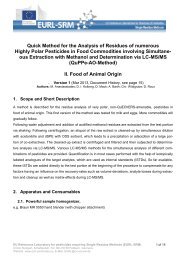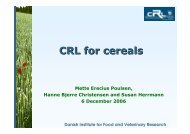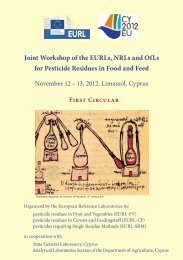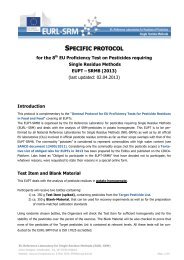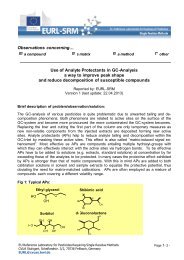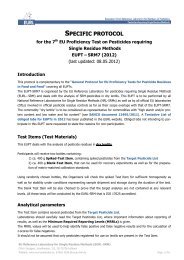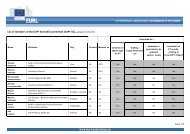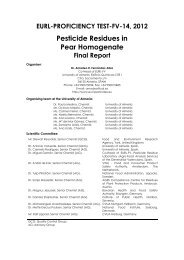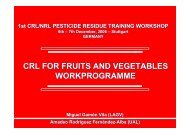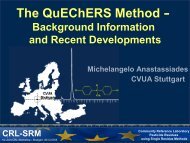QuPPe-AO - EURL | Residues of Pesticides
QuPPe-AO - EURL | Residues of Pesticides
QuPPe-AO - EURL | Residues of Pesticides
You also want an ePaper? Increase the reach of your titles
YUMPU automatically turns print PDFs into web optimized ePapers that Google loves.
5.7. Calibration and Calculations<br />
5.7.1. Using ISTD<br />
5.7.1.1. Where ISTD is added to the sample before any aliquotation:<br />
Follow the latest version <strong>of</strong> <strong>QuPPe</strong>-PO-Method. To ensure similar concentration <strong>of</strong> the ISTD is sample<br />
extracts and calibration standards it is reasonable to prepare the calibration standards in such a way that<br />
the ratio mISTD sample / mISTD cal mix equals 40 (to account for the final volume <strong>of</strong> the raw extract <strong>of</strong> 20 mL and<br />
the 1:1 dilution during cleanup). The absolute masses <strong>of</strong> the ISTD-WS I and II do not need to be neces-<br />
sarily known.<br />
5.7.1.2. Where ISTD is added to an aliquot <strong>of</strong> the extract<br />
Follow the latest version <strong>of</strong> <strong>QuPPe</strong>-PO-Method. When adding the ISTD to an aliquot <strong>of</strong> the extract (e.g. 1<br />
mL) it is mandatory to know the exact concentration <strong>of</strong> matrix-equivalnts per mL extract. If water adjust-<br />
ment is done as described in 5.2.2, the total volume <strong>of</strong> the raw extract can be assumed to be exactly 20<br />
mL. Considering the 2-fold dilution during the cleanup step 1 mL sample extract will represent 1/40 th <strong>of</strong> the<br />
test portion (ma). The mass <strong>of</strong> the ISTD to be added to an aliquot (mISTD aliquot ) should be scaled according<br />
to the aliquot volume used (Valiquot) with the ISTD mass ratio (mISTD aliquot / mISTD cal mix ) being important for<br />
the calculation.<br />
5.7.2. Not using ISTD<br />
If no appropriate ISTDs are used it is <strong>of</strong> high importance to properly compensate for matrix effects. For the<br />
compensation <strong>of</strong> matrix effects matrix-matched calibrations (5.5.2) and the standard additions approach<br />
(5.5.3) are recommended. In both cases the assumption is made that the total volume <strong>of</strong> the raw sample<br />
extract is exactly 20 mL, which is then diluted by a factor <strong>of</strong> 2. Adjustment <strong>of</strong> the water content (and ex-<br />
tract volume) in the sample is thus paramount.<br />
5.7.2.1. Calculations when employing matrix-matched calibration without ISTD<br />
Follow the latest version <strong>of</strong> <strong>QuPPe</strong>-PO-Method.<br />
In the formula multiply Vend by two to account for the 2-fold dilution in the cleanup step.<br />
EU Reference Laboratory for pesticides requiring Single Residue Methods (<strong>EURL</strong>-SRM)<br />
CVUA Stuttgart, Schaflandstr. 3/2, DE-70736 Fellbach, Germany<br />
Website: www.eurl-pesticides.eu, E-Mail: <strong>EURL</strong>@cvuas.bwl.de<br />
12 <strong>of</strong> 15



